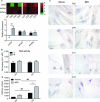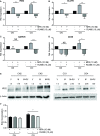MPA alters metabolic phenotype of endometrial cancer-associated fibroblasts from obese women via IRS2 signaling
- PMID: 35816477
- PMCID: PMC9273069
- DOI: 10.1371/journal.pone.0270830
MPA alters metabolic phenotype of endometrial cancer-associated fibroblasts from obese women via IRS2 signaling
Erratum in
-
Correction: MPA alters metabolic phenotype of endometrial cancer-associated fibroblasts from obese women via IRS2 signaling.PLoS One. 2024 Dec 3;19(12):e0315116. doi: 10.1371/journal.pone.0315116. eCollection 2024. PLoS One. 2024. PMID: 39625949 Free PMC article.
Abstract
Obese women have a higher risk of developing endometrial cancer (EC) than lean women. Besides affecting EC progression, obesity also affects sensitivity of patients to treatment including medroxprogesterone acetate (MPA). Obese women have a lower response to MPA with an increased risk for tumor recurrence. While MPA inhibits the growth of normal fibroblasts, human endometrial cancer-associated fibroblasts (CAFs) were reported to be less responsive to MPA. However, it is still unknown how CAFs from obese women respond to progesterone. CAFs from the EC tissues of obese (CO) and non-obese (CN) women were established as primary cell models. MPA increased cell proliferation and downregulated stromal differentiation genes, including BMP2 in CO than in CN. Induction of IRS2 (a BMP2 regulator) mRNA expression by MPA led to activation of glucose metabolism in CO, with evidence of greater mRNA levels of GLUT6, GAPDH, PKM2, LDHA, and increased in GAPDH enzymatic activity. Concomitantly, MPA increased the mRNA expression of a fatty acid transporter, CD36 and lipid droplet formation in CO. MPA-mediated increase in glucose metabolism genes in CO was reversed with a progesterone receptor inhibitor, mifepristone (RU486), leading to a decreased proliferation. Our data suggests that PR signaling is aberrantly activated by MPA in CAFs isolated from endometrial tissues of obese women, leading to activation of IRS2 and glucose metabolism, which may lead to lower response and sensitivity to progesterone in obese women.
Conflict of interest statement
The authors have declared that no competing interests exist.
Figures





Similar articles
-
Aberrant upregulation of CDK1 contributes to medroxyprogesterone acetate (MPA) resistance in cancer-associated fibroblasts of the endometrium.Biochem Biophys Res Commun. 2022 Nov 5;628:133-140. doi: 10.1016/j.bbrc.2022.08.088. Epub 2022 Sep 1. Biochem Biophys Res Commun. 2022. PMID: 36084551
-
[Study on the treatment of high dose mifepristone and progesterone in endometrial carcinoma].Zhonghua Fu Chan Ke Za Zhi. 2003 Sep;38(9):552-5. Zhonghua Fu Chan Ke Za Zhi. 2003. PMID: 14680611 Clinical Trial. Chinese.
-
MET Inhibits the Proliferation of EC Cells by Increasing MPA Sensitivity.Altern Ther Health Med. 2023 Jul;29(5):334-341. Altern Ther Health Med. 2023. PMID: 37171945
-
Medroxyprogesterone acetate causes the alterations of endoplasmic reticulum related mRNAs and lncRNAs in endometrial cancer cells.BMC Med Genomics. 2019 Nov 12;12(1):163. doi: 10.1186/s12920-019-0601-9. BMC Med Genomics. 2019. PMID: 31718641 Free PMC article.
-
Reproductive epidemiology of glial tumors may reveal novel treatments: high-dose progestins or progesterone antagonists as endocrino-immune modifiers against glioma.Neurosurg Rev. 2019 Jun;42(2):351-369. doi: 10.1007/s10143-018-0953-1. Epub 2018 Feb 17. Neurosurg Rev. 2019. PMID: 29453736 Review.
Cited by
-
Correction: MPA alters metabolic phenotype of endometrial cancer-associated fibroblasts from obese women via IRS2 signaling.PLoS One. 2024 Dec 3;19(12):e0315116. doi: 10.1371/journal.pone.0315116. eCollection 2024. PLoS One. 2024. PMID: 39625949 Free PMC article.
References
-
- Reeves GK, Pirie K, Beral V, Green J, Spencer E, Bull D. Cancer incidence and mortality in relation to body mass index in the Million Women Study: cohort study. BMJ (Clinical research ed). 2007;335(7630):1134. doi: 10.1136/bmj.39367.495995.AE - DOI - PMC - PubMed
-
- American Cancer Society. Cancer Facts & Figures 2021. American Cancer Society. 2021.
Publication types
MeSH terms
Substances
LinkOut - more resources
Full Text Sources
Research Materials
Miscellaneous

